Growing pines in colanders
I have wanted to try growing pines in plastic colanders for a while and finally got around to it. In the book ‘Pines’ published by Stone Lantern there is an article titled ‘Pine from seed’ written by Kusida Matsuo that explains how he grows pine seedlings in plastic colanders using 7 parts sand and 3 parts akadama with no organic material. This provides excellent aeration of the roots and promotes vigorous growth. The only downside to this technique is that you must water the trees several times a day to keep the roots from drying out and fertilize heavily because the potting mix and colander drain very quickly. Skipping a day of watering could prove fatal to the tree.
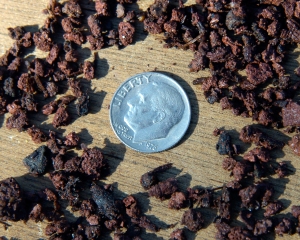 I am going to use 100% crushed lava as my potting mix. Our bonsai club buys about 100 bags a year from Roy Nagatoshi in California. The shipping is steep but the quality of his material is the best I have found. As you can see the lava pieces are fairly small. It drains well but still maintains some moisture in all those tiny pockets.
I am going to use 100% crushed lava as my potting mix. Our bonsai club buys about 100 bags a year from Roy Nagatoshi in California. The shipping is steep but the quality of his material is the best I have found. As you can see the lava pieces are fairly small. It drains well but still maintains some moisture in all those tiny pockets.
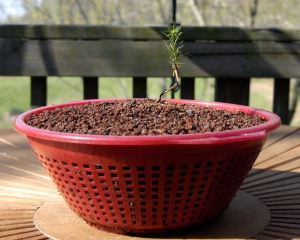 I decided to pot 2 pines. The first is a dwarf variety Japanese White Pine ‘Kokonoe’ that I grew from seed planted last spring. I wired the seedling and planted it in an 8 inch colander.
I decided to pot 2 pines. The first is a dwarf variety Japanese White Pine ‘Kokonoe’ that I grew from seed planted last spring. I wired the seedling and planted it in an 8 inch colander.
 As you can see there are lots of fresh buds.
As you can see there are lots of fresh buds.
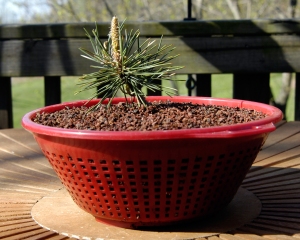 The second tree I chose is a Japanese Black Pine ‘Kotobuki’. This is a one year old Kotobuki scion that I grafted onto Black Pine rootstock.
The second tree I chose is a Japanese Black Pine ‘Kotobuki’. This is a one year old Kotobuki scion that I grafted onto Black Pine rootstock.
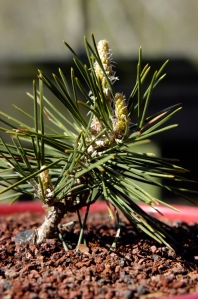 You can see the sealed scar at the base where I removed the the top of the Black Pine. There are several strong candles emerging.
You can see the sealed scar at the base where I removed the the top of the Black Pine. There are several strong candles emerging.
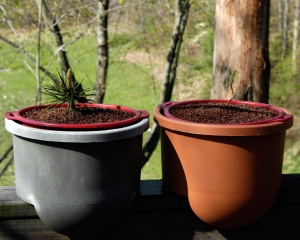 Matsuo’s technique placed one small 6 inch colander inside another larger 8 inch colander. I placed my colander inside a plastic deck rail pot filled with more crushed lava. The reason I chose to do this is for convenience. I wanted to have the pots on my deck so I could easily water the trees as I rushed out to work each morning. A second reason is the exposed colander would dry out quickly with a little wind and the deck rail pot should solve most of this problem. If my potting mix appears to be drying out as summer gets hot I will probably apply a thin layer of leaf mulch to slow evaporation.
Matsuo’s technique placed one small 6 inch colander inside another larger 8 inch colander. I placed my colander inside a plastic deck rail pot filled with more crushed lava. The reason I chose to do this is for convenience. I wanted to have the pots on my deck so I could easily water the trees as I rushed out to work each morning. A second reason is the exposed colander would dry out quickly with a little wind and the deck rail pot should solve most of this problem. If my potting mix appears to be drying out as summer gets hot I will probably apply a thin layer of leaf mulch to slow evaporation.
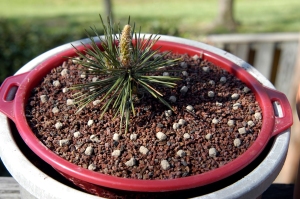 Finally I lightly pressed seabird guano pellets into the top of the potting mix. Seabird guano is organic and high in nitrogen. As the tree grows I will increase the amount of fertilizer.
Finally I lightly pressed seabird guano pellets into the top of the potting mix. Seabird guano is organic and high in nitrogen. As the tree grows I will increase the amount of fertilizer.
Update Spring 2014
The trees did well in the growing season however they did not make it through a rough winter despite burying the pots in the ground. I found this technique required to much attention with daily watering and the pots began to fall apart after just one year, therefore I am not going to try this technique again.
Have fun!

April 13, 2015 at 5:36 pm
Sorry, just read the 2014 results. Bummer. I have plants larger roughly 3-6 years old in colanders. Recently survived a somewhat late cold winter and are doing fine now. I think the young grafts can not handle the openness of the colanders. Maybe after 5 years in a training pot then colander from 6-15 years after…
May 10, 2015 at 12:39 pm
You may be right about recent grafts needing more nursing early however I found the baskets disintegrated too fast and now use grow trays with a mesh bottom almost exclusively. I can leave them on the ground to root through the mesh and get more robust growth.